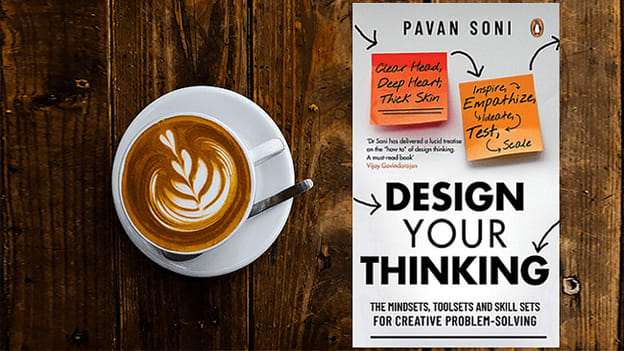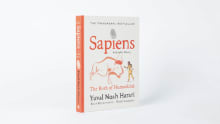It is the time to 'Design Your Thinking'

When was the last time you paused to think about the way you think? If you listen to the Nobel laureate Daniel Kahneman, almost 95 percent of our thinking happens in an automatic mode --- the effortless, instinctive, and mostly biased way of thinking. Only the remaining 5 percent is the more deliberate, often lazy and effortful thinking, which helps solve complex problems elegantly. As we are confronted with increasingly multifaceted and complex problems our approach of problem solving also must become more holistic and complex (and not complicated) and this won’t happen effortlessly.
Over the last 15 years, I have been involved in teaching, executive coaching, researching, and training on creative problem solving and have engaged with a wide range of people on how to be better problem solvers. The distillation of over 300 such engagements is that, if left alone, most of us would resort to a gut-feel based commonsensical approach of problem solving, which often leads to suboptimal outcomes. And as any manager or an entrepreneur would agree progression of one’s career hinges on how well one can understand, scope, define, and then solve problems permanently. One would also admit that understanding a problem is becoming a far more premium skill than solving it, for the latter can still be delegated or outsourced, but not so much the former.
In this article, I discuss some of the pointers of thinking clearly and creatively as captured in my recently released book, Design Your Thinking. Published by Penguin Random House, the book offers quintessential toolsets, skillsets, and mindsets for creative problem solving while building on the extant research and practices of design thinking. With over 30 case studies, mostly from Indian organizations, the book addresses the widely held misconception that design thinking is about product design, that too exclusively in the hi-tech space. Further, the book presents distilled insights from over 50 research papers and equal number of books on how to unleash one’s creativity in a wide range of contexts and to become a more disciplined problem solver. Here, I would present three core insights from the book, that would hopefully change your perspective towards design thinking and encourage you to read the book.
Design thinking has truly gone beyond designers
With its roots in industrial and product design, design thinking is often narrowly associated with the world of the tangibles – a good looking furniture, a clever piece of consumer technology, or everyday gadgets. While this view remains deeply entrenched in many industries, there is a growing realization that the principles and practices of design can well be adopted to solve a wide arena of problems, ranging from employee engagement to customer satisfaction and process improvements. The online grocery company, Bigbasket adopts the principles of design thinking to enhance the interaction between its delivery executive and the customers. Tanishq leverages the tenets of empathy and prototyping to create better working conditions for its karigars who remain largely unattended in the relatively unorganized jewelry manufacturing industry.
The word ‘design’ in design thinking often makes one to narrowly associate it with designing, as if the outcome is to device better designs, but in essence the approach is a holistic, systematic, human-centric means of problem solving. Through a host of examples from a non-product context, the book attempts to offer confidence to the audience that almost anyone faced with any problem can be a better problem solver. You don’t have to be a ‘designer’ to adopt the tenets of design thinking.
Tools and skills are sterile without appropriate mindsets
Any learning must be anchored around the pillars of toolsets, skillsets and suitable mindsets. Merely learning the tools or even honing the skills through practice are insufficient, for a shift in mindset is key to bring about a lasting impact. For instance, if someone has to be a counselor, the tools could be in the form of surveys, checklists, or diagnostic methods, whereas skill involve listening, probing, or deductive reasoning. However, if the ‘well trainer’ counselor lacks the mindsets of being non-judgmental, or doesn’t demonstrate empathy, she would never be as effective, let alone excel in her career.
Similarly, if one has to become a better problem solver, the requirement is to not only pick up tools and hone skill, but more importantly cultivate conducive mindset level changes. For instance, while discovering the problem or empathizing with the key stakeholders, some of the useful tools include mind mapping, empathy map, customer journey map, and pain-gain analysis; skills comprise being a good observer and non-intrusive interviewing methods. The key mindset is to be curious, open minded, and being comfortable with ambiguity. Which one is toughest to develop: the skills, tools, or mindsets? I guess, it is the mindset that takes a while to develop. That’s what the book focuses on – the key mindset levels shifts that would make you into a more sophisticated problem solver.
Ideas are only as good as the problems they solve
Through my years of conducting creative problem solving workshops and consulting work, I have had one major disappointment: What happens to the ideas after the workshop? I see a lot of excitement in creative problem solving sessions and some really good ideas too, but not many of such promising ideas make it to the light of the day. There are three reasons for this gap. Firstly, the problems haven’t been well defined and do not appear as priority for the leadership team, and hence the ensuing ideas mostly get lost. Secondly, the over reliance on external experts and coaches doesn’t enable robust capabilities to be seeded at the organization, as most of the knowledge and skills remain undocumented. Thirdly, there remains a general lack of structured approach and a discipline to follow-up on the ideas and to create real impact of those ideas through scale.
Design Your Thinking has attempted to address each of these issues. Firstly, by bringing to prominence the stage of Inspire, the book links the problem solving exercise to the strategic intent of the organization and how the leadership must craft a well-reasoned design brief. Secondly, there’s a chapter on Design Thinking in Action, presenting the outline of a typical two-day design thinking workshop and the approach one could take to host a similar endeavor at one’s organization or at a client’s premise. Thirdly, through a rigorous discourse on Scale and associated tools of measuring performance, the text offers sufficient fuel for a team to systematically take valuable ideas to a logical conclusion.
In summary, Design Your Thinking offers a domain-agnostic, function-independent, and practically relevant approach to problem solving, which is amicable to an Indian context and adopts an end to end view of how design thinking could make a difference between ad-hoc approaches of ideation versus a more reliable, repeatable, and scalable model. I hope you found this piece insightful and are excited to pick the book up. I look forward to hearing from you.















